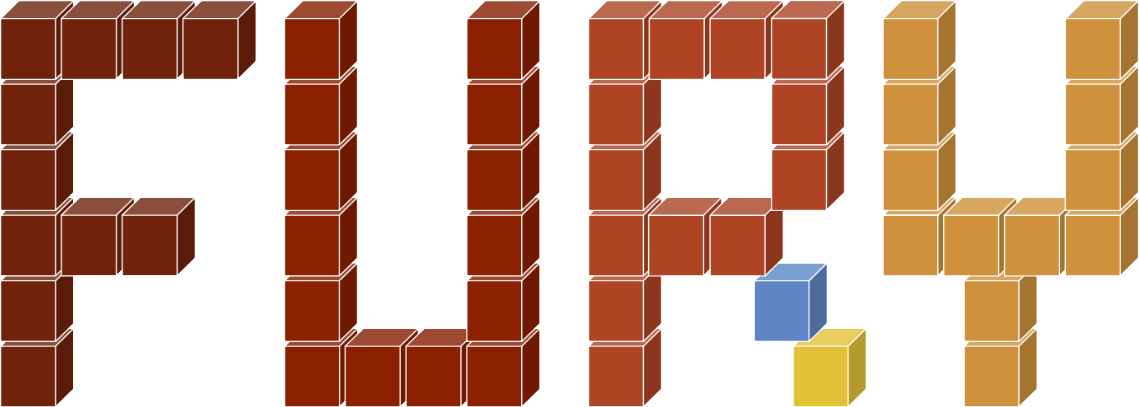

Google Summer of Code Final Work Product#
Name: Sajag Swami
Organisation: Python Software Foundation
Sub-Organisation: FURY
Project: FURY: Ribbon and Molecular Surface Representations for Proteins
Proposed Objectives#
Ribbon Representation
Molecular Surface Representation
Stretch Goals:
Stick Representation
Ball and stick Representation
Wire Representation
Pipes and Planks Representation
Sphere Representation
Objectives Completed#
Ribbon Representation
Ribbon diagrams, also known as Richardson diagrams, are 3D schematic representations of protein structure. Ribbon diagrams are generated by interpolating a smooth curve through the polypeptide backbone. α-helices are shown as coiled ribbons. β-strands as sheets, and non-repetitive coils or loops as lines or thin strips. It was implemented by using vtkProteinRibbonFilter. Generating a vtkPolyData of appropriate format required by vtkProteinRibbonFilter was initially unclear due to lack of examples. I was able to understand what kind of output the filter required after a meeting with mentors. Tests were added and a demo was created.
Pull Requests:
Ribbon representation: fury-gl/fury#452
Ribbon Representation demo: fury-gl/fury#452
Ball and Stick Representation
The ball-and-stick model is a molecular model of a chemical substance which displays both the three-dimensional position of the atoms and the bonds between them. The atoms are typically represented by spheres, connected by tubes which represent the bonds. It was created by using vtkOpenGLMoleculeMapper. Added vtkSimpleBondPerceiver for detection of bonds. Tests were added and a demo was created.
Pull Requests:
Ball and Stick Representation: fury-gl/fury#452
Ball and Stick Representation demo: fury-gl/fury#452
Stick Representation
Stick model is a special case of Ball and Stick model where atomic radius of all molecules is set equal to the radius of tubes used to create bonds. It was created by using vtkOpenGLMoleculeMapper. Tests were added and a demo was created.
Pull Requests:
Stick Representation: fury-gl/fury#452
Stick Representation demo: fury-gl/fury#452
Sphere Representation
In chemistry, a space-filling model, also known as a calotte or sphere model, is a type of three-dimensional (3D) molecular model where the atoms are represented by spheres whose radii are proportional to the radii of the atoms. It was created by using vtkOpenGLMoleculeMapper. Tests were added and a demo was created.
Pull Requests:
Sphere Representation: fury-gl/fury#452
Sphere Representation demo: fury-gl/fury#452
Objectives in Progress#
Molecular Surfaces
There are three types of molecular surfaces:
Van der Waals
Solvent Accessible
Solvent Excluded
Currently the first two molecular surfaces i.e. Van der Waals and Solvent Accessible are implemented. The code is based on the paper “Generating Triangulated Macromolecular Surfaces by Euclidean Distance Transform” by Dong Xu and Yang Zhang.
Pull Requests:
Molecular Surfaces Implementation: fury-gl/fury#492
Other Objectives#
2D Animated Surfaces
This was a simple demonstration that animated Two-Dimensional (2D) functions using FURY. Created a grid of x-y coordinates and mapped the heights (z-values) to the corresponding x, y coordinates to generate the surfaces. Used colormaps to color the surfaces.
Pull Requests:
Animated Surfaces: fury-gl/fury#362
Updated miscellaneous animations
Updated the demo of helical motion to stop using multiple line actors as discussed in the meeting.
Updated the demo of brownian motion to make it more scientifically useful (removed unnecessary rotation of camera during animation and box actor).
Display simulation data for brownian motion and helical motion animations (number of simulated steps for brownian motion and velocity of the particle for helical motion).
Created utility functions to make the code understandable and used these in emwave, helical and brownian animations.
Pull Requests:
Updated helical, brownian, emwave animations: fury-gl/fury#462
GSoC weekly Blogs
Weekly blogs were added for FURY’s Website.
Pull Requests:
First Evaluation: fury-gl/fury#475
Second Evaluation: fury-gl/fury#493
Timeline#
Date |
Description |
Blog Link |
|---|---|---|
Week 1(08-06-2021) |
Welcome to my GSoC Blog! |
|
Week 2(14-06-2021) |
First Week of coding: sphere model. |
|
Week 3(21-06-2021) |
Bonding algorithms, Ball and Stick model progress. |
|
Week 4(28-06-2021) |
VTK molecular visualization classes. |
|
Week 5(05-07-2021) |
Genesis of molecular module. |
|
Week 6(12-07-2021) |
Ribbon representation, updated molecular module (more pythonic) |
|
Week 7(19-07-2021) |
More features to molecular, updated misc. animations. |
|
Week 8(26-07-2020) |
Ribbon to molecular, tests for molecular, animated surfaces. |
|
Week 9(02-08-2021) |
Optimized molecular with mentors, GSoC blogs to FURY docs. |
|
Week 10(09-08-2021) |
Bounding box, molecular tutorial, molecular surfaces progress. |
|
Week 11(16-08-2021) |
Molecular Surfaces (VDW, SAS) implementation. |
Detailed weekly tasks and work done can be found here.
